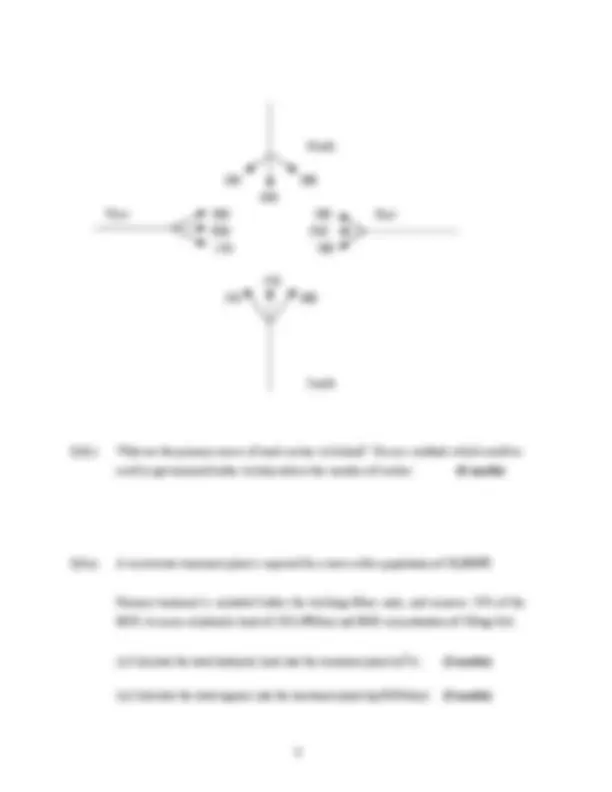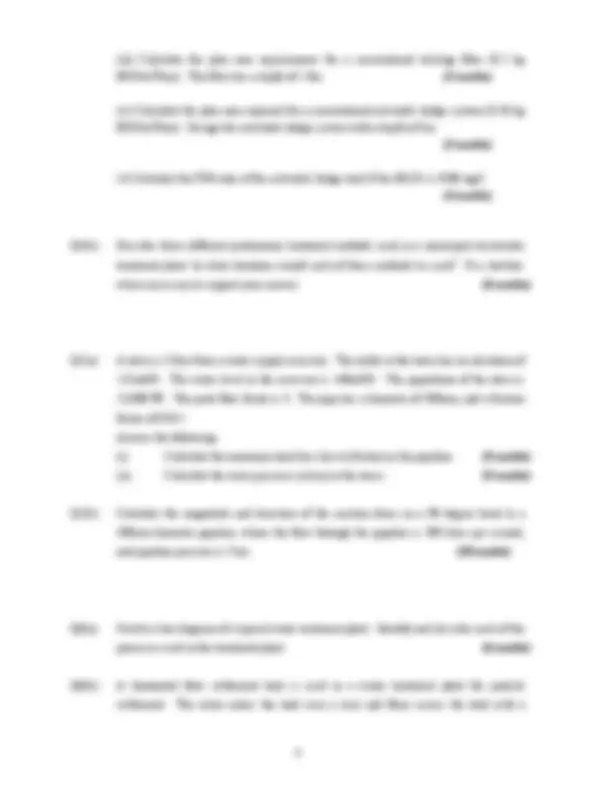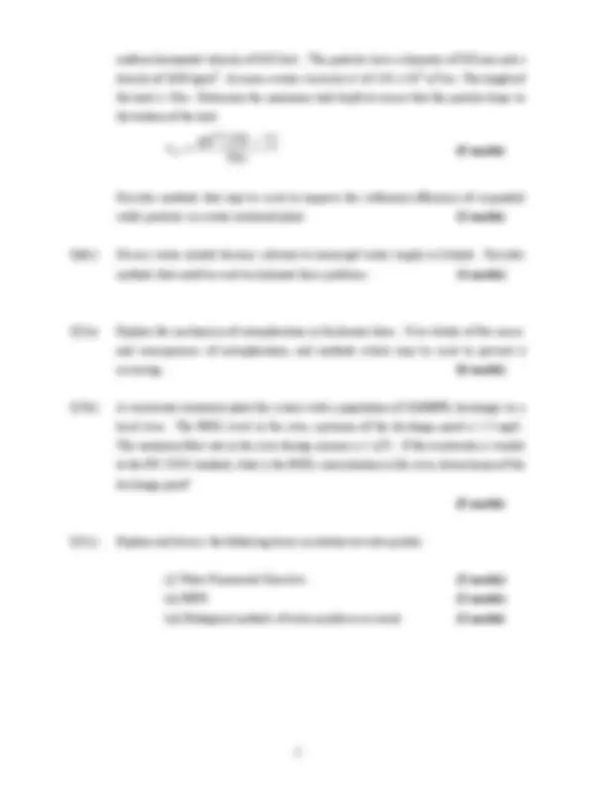





Study with the several resources on Docsity

Earn points by helping other students or get them with a premium plan


Prepare for your exams
Study with the several resources on Docsity

Earn points to download
Earn points by helping other students or get them with a premium plan
Community
Ask the community for help and clear up your study doubts
Discover the best universities in your country according to Docsity users
Free resources
Download our free guides on studying techniques, anxiety management strategies, and thesis advice from Docsity tutors
Main points of this past exam are: Modified Rational Method, Rational Equation, Calculate Rainfall Intensity, Dillon Equation, Quantity of Hydrological Runoff, Interception Storage, Home Composting Units, Waste Management Hierarchy
Typology: Exams
1 / 5

This page cannot be seen from the preview
Don't miss anything!




Instructions Answer 5 questions All questions carry equal marks.
Examiners: Mr. L O’ Driscoll Dr. N Power Mr. A. M. Maloney Mr J. Murphy Mr. J. Lapthorne Mr. J. Kindregan
Q1(a) Calculate the peak runoff from a 95m x 150m car park for a 25 year return period storm, and 60 minute duration. Use the Dillon equation (below) to calculate rainfall intensity. Use the Modified Rational Method to calculate runoff from the catchment areas. Assume 70% runoff from impermeable areas. Cr = 1.3. Cv = PR/100. (4 marks)
Dillon Equation (^35) p^15 t
Rational Equation Q(l/s) = 2.78.Cv.C (^) r. A(ha) I(mm/hr)
If the peak flow allowed from the site is 3 litres/sec/ha, discuss a number of methods that could be used to ensure that this allowable peak is not exceeded. (^) (4 marks)
Q1(b) Explain the primary factors that influence the quantity of hydrological runoff from a rural catchment area. (6 marks)
Q1(c) Explain the following hydrological terms: (i) Evapotransporation (ii) Interception storage (iii) Rain-gauges (6 marks)
Q2(a) With regard to waste management, list the advantages and disadvantages of each of the following:: (i) Home composting units (^) (4 marks) (ii) Incineration (4 marks)
Q2(b) Describe the waste management hierarchy with reference to municipal solid waste management. How does this relate to the management of biodegradable municipal waste? (4 marks)
Q2(c) Describe, with the aid of sketches, a typical cross-section through a municipal solid waste landfill site. Discuss briefly the main elements of landfill construction. (4 marks)
Q2(d) Describe the statutory landfill site selection process used by local authorities in Ireland. (4 marks)
Q3(a) Explain the methodology involved when conducting a parking survey for an existing shopping centre car park. Give typical examples of forms used. (^) (6 marks)
Q3(b) The following traffic flows in pcu/hour were determined at a roundabout, based on traffic flow surveys. Is the roundabout capacity adequate (based on your analysis) given:
11m wide weaving sections, 42 m long in each quadrant, e 1 = 8m, e 2 = 9m
w
w w e Q
, e = e^1 + 2 e^2
(8 marks)
(iii) Calculate the plan area requirements for a conventional tricking filter (0.1 kg BOD/m^3 /day). The filter has a depth of 1.8m. (3 marks)
(iv) Calculate the plan area required for a conventional activated sludge system (0.56 kg BOD/m^3 /day). Design the activated sludge system with a depth of 4m. (3 marks)
(v) Calculate the F/M ratio of the activated sludge tank if the MLSS is 3500 mg/l. (4 marks)
Q4(b) Describe three different preliminary treatment methods used in a municipal wastewater treatment plant. In what situations would each of these methods be used? Use sketches where necessary to support your answer. (6 marks)
Q5(a) A town is 22km from a water supply reservoir. The outlet at the town has an elevation of +32mOD. The water level in the reservoir is +68mOD. The population of the town is 25,000 PE. The peak flow factor is 3. The pipe has a diameter of 500mm, and a friction factor of 0.015. Answer the following: (i) Calculate the maximum head loss due to friction in the pipeline. (5 marks) (ii) Calculate the water pressure (in bar) at the town. (5 marks)
Q5(b) Calculate the magnitude and direction of the reaction force on a 90 degree bend in a 400mm diameter pipeline, where the flow through the pipeline is 200 litres per second, and pipeline pressure is 5 bar. (10 marks)
Q6(a) Sketch a line diagram of a typical water treatment plant. Identify and describe each of the processes used in the treatment plant. (6 marks)
Q6(b) A horizontal flow settlement tank is used in a water treatment plant for particle settlement. The water enters the tank over a weir and flows across the tank with a
uniform horizontal velocity of 0.015m/s. The particles have a diameter of 0.01mm and a density of 2650 kg/m^3. Assume a water viscosity ( v) of 1.01 x 10-6^ m^2 /sec. The length of the tank is 10m. Determine the maximum tank depth to ensure that the particle drops to the bottom of the tank.
s
(5 marks)
Describe methods that may be used to improve the settlement efficiency of suspended solids particles in a water treatment plant. (3 marks)
Q6(c) Discuss water related diseases relevant to municipal water supply in Ireland. Describe methods that could be used to eliminate these problems. ( 6 marks)
Q7(a) Explain the mechanism of eutrophication in freshwater lakes. Give details of the causes and consequences of eutrophication, and methods which may be used to prevent it occurring. (6 marks)
Q7(b) A wastewater treatment plant for a town with a population of 10,000PE, discharges to a local river. The BOD 5 level in the river, upstream of the discharge point is 1.5 mg/L. The minimum flow rate in the river during summer is 1 m^3 /s. If the wastewater is treated to the EU 25/35 standard, what is the BOD 5 concentration in the river, downstream of the discharge point? (5 marks)
Q7(c) Explain and discuss the following terms in relation to water quality:
(i) Water Framework Directive (3 marks) (ii) REPS (3 marks) (iii) Biological methods of water quality assessment (3 marks)